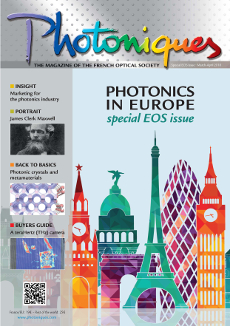Photonic devices and applications
- Details
- Published on 25 April 2018
Articles published in Photoniques special EOS issue, march-april 2018.

How can attosecond pulse train interferometry interrogate electron dynamics?

Light pulses of sub-100 as (1 as=10-18 s) duration, with photon energies in the extreme-ultraviolet (XUV) spectral domain, represent the shortest event in time ever made and controlled by human beings. Their first experimental observation in 2001 has opened the door to investigating the fundamental dynamics of the quantum world on the natural time scale for electrons in atoms, molecules and solids and marks the beginning of the scientific field now called attosecond science.
Read the article (free access)
Lighting: a driver of the sustainable revolution

Some of the most important things in life are taken for granted, and nowhere is this truer than with light. In this article, we will look at some important milestones marking light’s path from human evolution to sustainable revolution, challenges facing the modern lighting industry as well as the world we live in, and what the future promises. In a sense, a new revolution is at hand. It would be hard to overestimate the fundamental importance of light as it shapes virtually everything we sense and experience.
Read the article (free access)
Gold nanoparticles as nanosources of heat

Under illumination at their plasmonic resonance wavelength, gold nanoparticles can absorb incident light and turn into efficient nanosources of heat remotely controllable by light. This fundamental scheme is at the basis of an active field of research coined thermoplasmonics and encompasses numerous applications in physics, chemistry and biology at the micro and nano scales.
Read the article (free access)
Retinal prosthesis system: a revolutionary advancement for the severely visually impaired

Despite all the advancements in modern ophthalmology, disease can affect vision, resulting in blindness. Worldwide, there are 200 000 people who have retinitis pigmentosa, 2 million with age-related macular degeneration (AMD) and 6 million have other forms of sight loss.
Read the article (free access)






